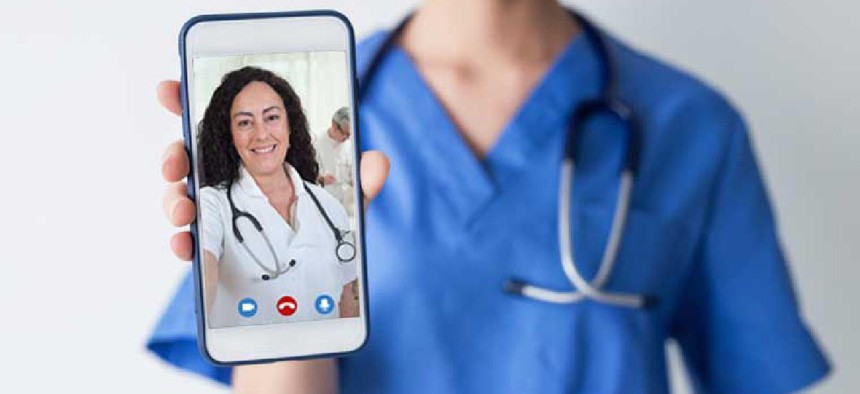Telehealth app helps medical staff find specialists

With the National Emergency Tele-Critical Care Network app, users can set up virtual critical care wards and help medical staff find available remote experts by searching for an on-duty provider by specialty.
A nurse in Guam struggling to stabilize a COVID-19 patient got help within minutes from a physician at the Brooke Army Medical Center in Houston and a nurse at the Naval Medical Center San Diego. Using telehealth, they identified the problem and walked the nurse through a procedure that likely saved the patient’s life.
National Emergency TeleCritical Care Network
Department of Health and Human Services and Department of Defense
Click here for all the 2021 Public Sector Innovation winners
The technology they used is the National Emergency Tele-Critical Care Network (NETCCN), a cloud-based, low-resource, standalone health information management system that uses cellular communication networks. Created by the Health and Human Services Department’s Office of the Assistant Secretary for Preparedness and Response (ASPR) in partnership with the Army’s Telemedicine and Advanced Technology Research Center (TATRC), the NETCCN app enables users to set up virtual critical care wards and help medical staff find available remote experts by searching for an on-duty provider by specialty.
“The way we got this kickstarted was because of COVID,” said Joseph Lamana, director of ASPR’s Readiness Division. “One of the biggest challenges to the health care system, at least during COVID, was a lack of experienced or skilled health care providers in the critical care area. One of the upsides of this particular capability -- besides the fact that it’s really, really easy to use and it’s not your typical telemedicine system – [is that] we could really come into a rural hospital and provide this capability.”
Clinicians and physicians download the app from the Apple App or Google Play stores to their handheld device and can then communicate synchronously or asynchronously through audio and video calls and chats and share secure photos and documents. NETCCN also can help with e-consults, remote home monitoring, tiered staffing and relief coverage – an especially critical area as the United States has lost since February 2020, according to the Bureau of Labor Statistics.
NETCCN, funded through the Coronavirus Aid, Relief and Economic Security Act, builds on a similar platform TATRC had in place for warfighters. But “TATRC was using predominantly military doctors and nurses, military specialists as the person on the other end of the phone,” Lamana said. “What this program allowed us to do is expand to a vast network of civilian providers.”
That also expands the data that HHS and TATRC can collect. Part of NETCCN’s capability is collecting and curating data to aggregate and visualize it to “not only improve medical decision-making at the bedside but … also drive patient care algorithms, and support leadership population-health decision making,” according to an HHS fiscal 2022 report.
NETCCN, which complies with Health Insurance Portability and Accountability Act requirements, launched in October 2020 and quickly deployed to coronavirus hot spots worldwide. The next month, more than 235 local and distance clinicians downloaded and used the platform to manage nearly 100 patients.
Requirements for NETCCN to go live include a waiver of state licensure requirements by law or executive order, a local IT contact who can work with NETCCN to solve any technical problems and availability of personal or facility-owned devices. The platform does not need access to the local hospital network and doesn’t require any hardware or wiring to be installed.
Local hospitals and health care systems can also license the application to deliver services within their own organization using their own clinical staff.
Lamana said ASPR is just getting started. “What we would like to get to is that through the NETCNN app that might have access directly to some of the hardware that’s surrounding a patient in the ICU,” he said. “They might be able to help an ICU at night because there’s not enough staff … and NETCNN can actually monitor remotely the ventilator, IV pumps, the cardiac monitor. As they’re monitoring it, they might be able to make adjustments to the ventilator at the best [and] at the least contact people at the bedside or nurse’s station.”
He expects to transition NETCCN from TATRC to ASPR in the next six months so that it can be fully operationalized and ready for use by the 2022 hurricane season. Additionally, it will be integrated into HHS’ National Disaster Medical System, which activates when a state requests support.
“It will be another tool in the toolbox” of disaster management, Lamana said.
NEXT STORY: OSCAL automates FedRAMP assessments





